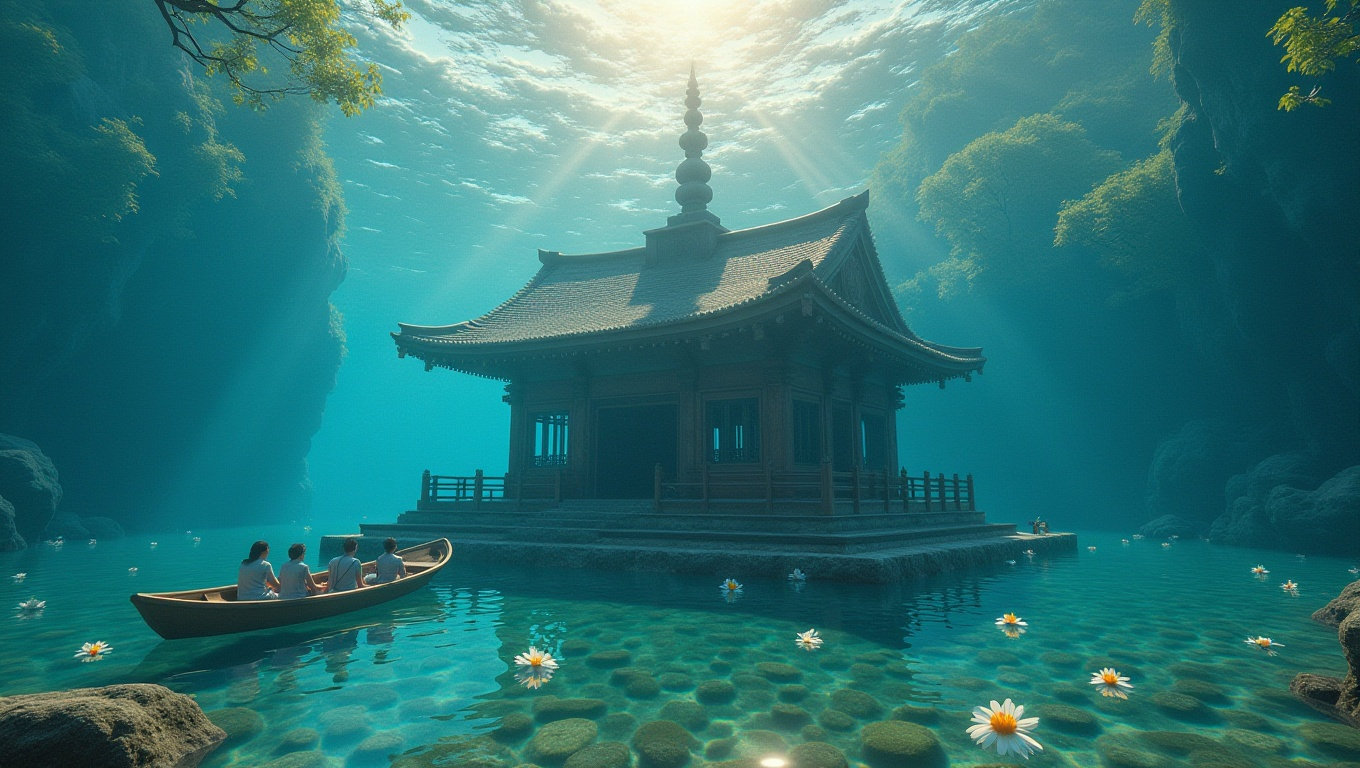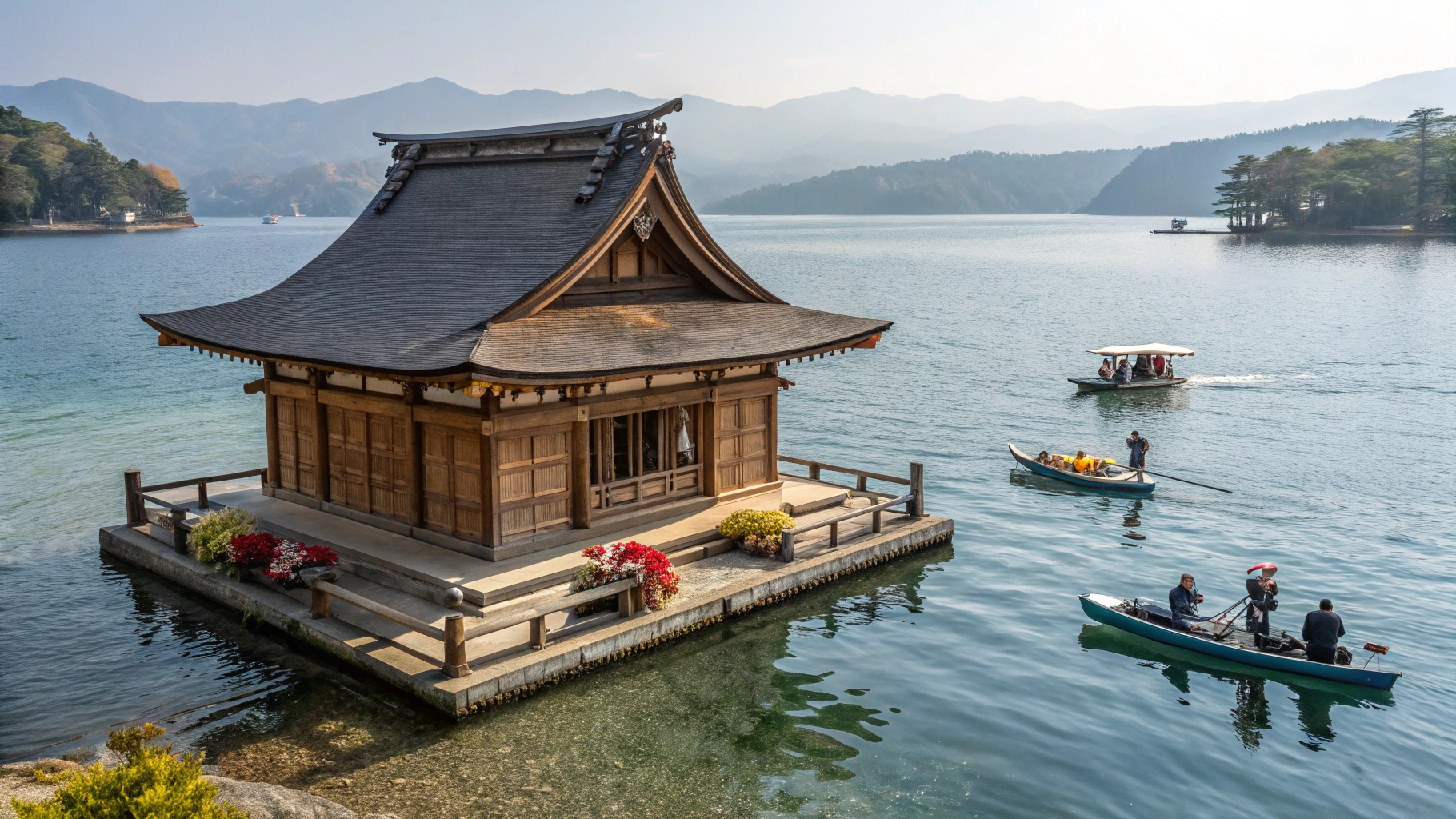

The Sunken Shrine of Memory
A silent shrine at the bottom of a clear mountain lake, dedicated to all that is lost but not forgotten.
This shrine's main hall rests perfectly preserved in the crystal-clear waters of a caldera lake. Visitors pray from boats on the surface, offering flowers that drift down to the silent world below.
History of the Shrine
A thousand years ago, a small, prosperous village existed in a remote, beautiful mountain valley. The village was known for its pure spring water and its beloved shrine to Omoikane, the kami of wisdom and memory. The villagers were the keepers of their region's oral histories and traditions. One year, a massive earthquake shifted the landscape, blocking the valley's only river outlet. Over the course of the next year, the pristine spring water slowly and inexorably filled the valley. The villagers were forced to evacuate, watching as their homes and, finally, the roof of their cherished shrine disappeared beneath the rising waters.
Years later, a monk returned to the area and discovered that the water was so incredibly clear that on a calm day, the entire village, including the shrine, could be seen perfectly preserved below, like a dream. He declared it a miracle. The shrine had not been destroyed, but transformed. It was no longer a shrine for one village, but a shrine for all things that are lost but not forgotten. It became a place of pilgrimage for those grieving a lost loved one, a lost home, or even a lost part of themselves.
The Enshrined Kami
Omoikane is the Shinto kami of wisdom, collective knowledge, and good counsel. In mythology, it was Omoikane who devised the brilliant plan to lure the sun goddess Amaterasu out of her cave. This kami is the embodiment of the power of thought and memory.
At this sunken shrine, Omoikane has taken on the role of the great archivist, the one who holds all the memories of the world in the clear, preserving depths of the water. He is not a god of grief, but of remembrance. Worshippers pray to him not to change the past, but for the strength to cherish its memory, for help in recalling a forgotten but important detail, and for access to the collective wisdom that the past holds. He teaches that what is lost to sight is not necessarily lost to the heart.
What to See
There is no shrine building on the shore. The only structure is a simple wooden pier where small rowboats can be rented. Visitors row out to the middle of the lake, directly above the submerged shrine. On calm, sunny days, the view is surreal: the dark wood of the torii gate and the elegant roof of the main hall are clearly visible dozens of meters below, fish swimming through the silent 'grounds'.
The act of worship is quiet and personal. Instead of coins, worshippers offer a single white chrysanthemum. They whisper a memory they wish to honor into the flower before gently placing it on the water's surface. The flower then slowly, gracefully sinks down through the clear water towards the silent shrine below, a physical offering descending into the world of memory.
Major Festivals
Once a year, on the anniversary of the day the last rooftop disappeared beneath the water, the 'Mizu-no-Soko Matsuri' (Water-Bottom Festival) is held. At dusk, hundreds of people row out onto the lake. Each boat carries a single floating lantern. At a coordinated moment, all the lanterns are lit and released onto the water. The lake becomes a sea of soft, flickering lights, a mirror of the starry sky above. It is a silent, communal act of remembrance, honoring the past that lies preserved in the depths below.
Support The Sunken Shrine of Memory
Your participation helps preserve this sacred site for future generations. Every digital offering contributes to real shrine preservation efforts across Japan.
By making an offering, you become part of a global community honoring Japanese spiritual traditions and supporting the cultural heritage that has been cherished for centuries.